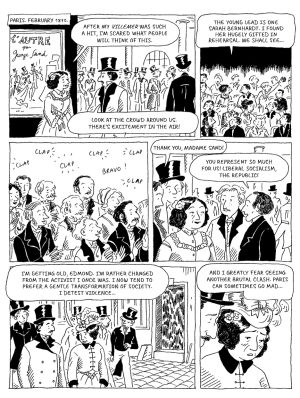Review by Colin Credle
Written by Severine Vidal and originally published in French, George Sand is an intimate primer on a literary iconoclast who came to prominence in the second half of 19th Century France. The more masculine George Sand pseudonym was used by author Amantine Lucile Aurore Dupin de Francueil to further her chances of publication in a male dominated trade, and she became known by her alias. Sand was impressively prolific in her writings, which included plays, novels and memoirs, and lived in interesting times of violent and lethal revolutions and barricades in the streets
Illustrator Kim Consigny’s style is endearing in its simplicity, reminiscent of newspaper comic strips with clean lines, little shading and some hatching. Fortunately, it’s not a story with a great deal of action, but more social interaction. Consigny’s style is well suited to salons of 19th century France and bed ridden heroes suddenly afflicted with typhus or ague.
As was often the case in the mid-1800’s, the talented and famous seemed to spend a lot of time together. George Sand knew Flaubert, Chopin and a number of other luminaries of the age. In fact, the structure of George Sand seems to jump in a linear fashion from personage to personage. It helps to read the Wikipedia page on George Sand to get a sense of who these other figures were not only in her life, but in French history as well as it’s difficult to read George Sand without the sense you’ve missed someone important by not recognizing their names. The challenge of recounting any history is that there tend to be too many characters in real life, but we benefit from Sand’s internal thoughts and dynamic personality as she contemplates the ideas of the times.
Sand distinguished herself by rebelling against gender defining roles of the times. She wore trousers because it was easier to get around town, as few would refuse her entrance to normally male only venues because she blended in with the other men. George Sand mentions in passing that women wearing trousers was illegal, in fact requiring a permit. Sand was vocal against the constraints of gender assigned social norms, choosing to smoke cigars, to openly engage in dalliances outside her marriage and to sue her husband to reclaim her property during a rather public divorce. Sand also had an affair with a famous actress of her day. She genuinely lived her life outside the bounds of acceptable behaviour at great risk to herself, and somehow avoided being a social outcast, at least as depicted in George Sand. Her books continued to sell well and sustain both her fame and finances. Unfortunately, her licentiousness did have impact on her children and her friendships, while challenging the loyalty of those around her.
George Sand excels in recounting the arc of Sand’s views on violence and political change. As a young woman she follows the revolutionary zeal of the day to destroy the foundations of society, which evolves later in life into a more universal antipathy to violence and war as agents of change. Vidal ensures George Sand is a good starting point to read about this time in history and the specific experience of George Sand, but leaves you with more questions. French history is, after all, a large subject to tackle and this rather lengthy graphic novel takes its time to tell it. At least today everyone can wear trousers.





